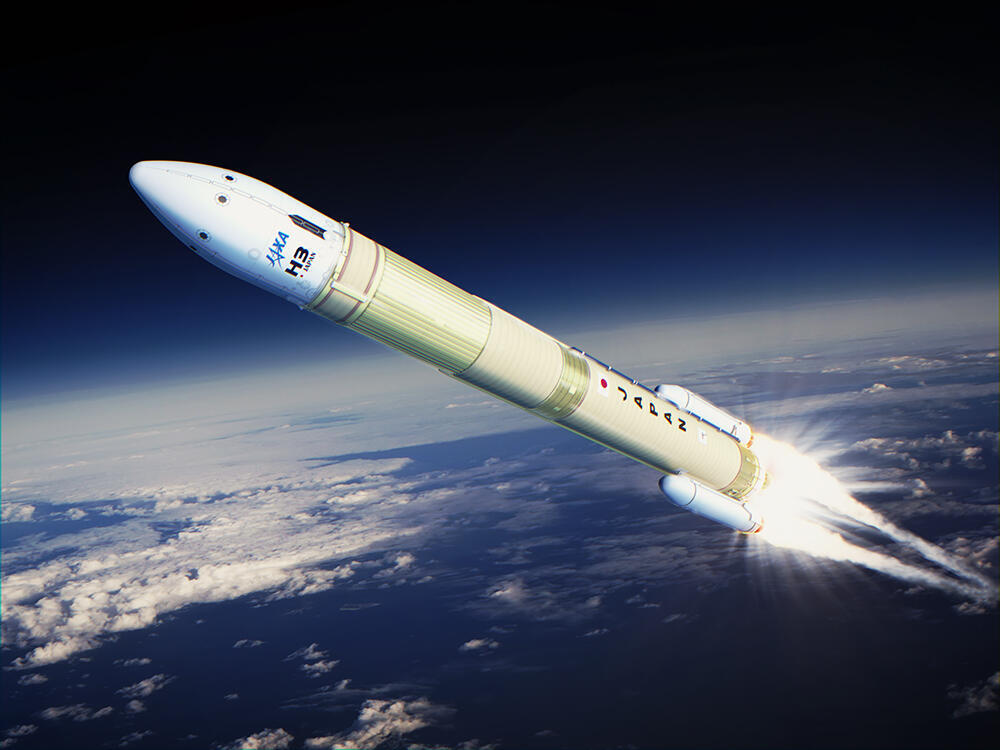
Research and Development Directorate

Numerical Simulation Technology - Essential Tool for H3 Launch Vehicle Development
At JAXA, the numerical simulation technology plays an essential role in developing and assembling a wide range of equipment and systems used for launch vehicles and related ground facilities. In this article, NEGISHI Hideyo, Senior Researcher of numerical simulation technology at the Research and Development Directorate, introduces the significance of the technology and its contribution to the H3 Launch Vehicle development.
Virtual experiment under artificially created extreme conditions
For the purpose of product development, the numerical simulation technology is widely used to conduct virtual experiments under computer-generated conditions. The technology is a long-time standard industrial process, which, particularly in the automobile manufacturing industry, will likely virtually eliminate the need for real-life experiments. At JAXA, substantial efforts have been made to study and develop the technology for the purpose of aircraft and rocket development over years since before the agency was reorganized from the preceding National Aerospace Laboratory of Japan (NAL).
NEGISHI describes the three major advantages of the numerical simulation technology, as follows:
"First, the technology enables precise reproduction of physical phenomena. Let me take a specific example from the cases of determining the effect of the acoustic vibration generated at rocket lift-off will have on the mounted satellite. Conventional real-life experiment processes for assessing acoustic effect, such as doing mock-ups and mock firing, have problems with the quality of produced data, represented by a large margin of error, which significantly reduce data availability."
In contrast, the numerical simulation technology can process precise 3D animated reproduction of physical phenomena, thus offering complex and diverse information needed to figure out the principle of acoustic waves transmitting through space. Numerical simulation is also strong in quantitative calculation for thrust levels, remaining service years, and others that are out of the capability of real-life experiments."
Simulation of H3 Launch Vehicle lift-off to predict acoustic waves
"Secondly, the technology has made it possible to artificially reproduce essentially inaccessible experiment conditions, including vacuum, airless, and nearly gravity-free conditions of the space environment. It is impossible to conduct a real-life experiment to assess, for example, the situation of liquids placed in a tank under such conditions. Numerical simulation can provide a solution to this limitation by giving an effective substitute for real-life space experiments, through computer generation of vacuum, microgravity or other experiment environments. Simulation results can be used for design examination to improve parts structure and many other issues."
Simulation of physical impact and thermal effect on the International Space Station (ISS) from the H-II Transfer Vehicle "KOUNOTORI" being fired while remaining docked to the ISS
"The third advantage of the numerical simulation technology is about its general versatility. In addition to space research, such as that conducted at JAXA, the technology is applied to a variety of general industrial purposes, including aerodynamic modeling for automotive design and verification of wind turbine blade structural design and so on. More recent applications have been pursued by the public health sector, notably including assessment of the airborne distance of droplets from sneezing. These examples represent applications of aeronautical and astronautical research and development efforts. I believe many more such achievements will be accumulated, inherited and introduced to other sectors, and such strong versatility constitutes a significant value of the technology."
Key technology to new rocket development
Numerical simulation processes advanced in tandem with the evolution of supercomputer systems that undertake the relevant calculation function, and around 2000, the progress reached the level that could support rocket development. Then, around 2010, we achieved capabilities for 3D simulation of the entire engine configuration. This achievement provided "a milestone innovation for rocket development processes" (NEGISHI). He gives the related story, as below:
"Before numerical simulation was available, rocket development projects started design work based only on concept studies. Design results were subject to a huge number of verification tests, which naturally detected a myriad of defects and problems that needed improvements. This often led to ceaseless redesign and retesting processes, resulting in prolonged development periods and swelling costs."
Now that numerical simulation is available, we have incorporated the process in the ongoing H3 Launch Vehicle development plan so that any potential defects can be identified before testing. This will allow us to minimize risk factors, which is expected to facilitate problem-free progress from assembly to operation."
The Research and Development Directorate is promoting the H3 Launch Vehicle development in cooperation with the Space Transportation Technology Directorate, leader of the project. NEGISHI describes the background of the cooperation, saying:

"We began to promote the cooperation before the project was launched around 2015. At the early concept development stage, the project team discussed the future need for numerical simulation process for design to solve possible technical issues to be detected by tests. This is how we started to make far-sighted efforts to develop the simulation technology."
NEGISHI also touches on another major numerical simulation task performed related to the LE-9 engine in order to reduce the turbine fatigue, an issue facing the H3 Launch Vehicle development.
"The system is designed so that the turbine rotates to turn the fuel pump so as to supply fuel to the engine. The turbine is composed of two rows of rotor blades that resemble wind turbine blades. In the designed system, strong gas jet is applied to turn the blades, a step necessary for turbine rotation. We detected an issue related to this process, which is, when the rotation frequency exceeds a certain level, the blades begin to sway inappropriately, occasionally crack depending on the situation. In order to solve this issue, we decided to examine geometric change options and run numerical simulation programs to assess various plans."
Numerical simulations were also performed to assess the internal temperature of the combustor.
Numerical simulation for LE-9 hydrogen turbine engine
Toward defect-free, highly efficient development
Looking back on the historical development of the numerical simulation technology, NEGISHI expresses his justifiable sense of satisfaction with the contribution made through the technology built into an essential design development tool to outdate the real-life experiment-based standard.
Unfortunately, however, the first H3 test launch initially scheduled for fiscal 2020 was postponed due to issues with the LE-9 engine detected by a final phase test. NEGISHI explains the relevant current situation and future outlook.
"Two major issues have been identified, each being associated with openings detected on the internal wall of the combustor and fatigue of the hydrogen turbine. We are exerting our utmost efforts to overcome these challenges."
"Numerical simulation is still a developing technology, with a lot remaining to be improved. At present, the technology is yet to be capable of comprehensive simulation of the entire configuration of complicated mechanisms such as liquid rocket engines, though enabling adequate functionality for individual component simulations, such as for a pump and turbine, separately. The stated defects of the H3 Launch Vehicle were identified by a test of the overall engine structure with all components put together. Therefore, our immediate future challenge is to refine the technology to be capable of comprehensive simulation of the entire engine configuration. We will continue to work together to develop the numerical simulation technology, aiming to innovate a new space development process."
Profile

|
|
|---|
All the images are copyrighted ©JAXA unless otherwise noticed.
- Home>
- Global Activity>
- Public Relations>
- JAXA’s>
- JAXA's No.84>
- Numerical Simulation Technology - Essential Tool for H3 Launch Vehicle Development